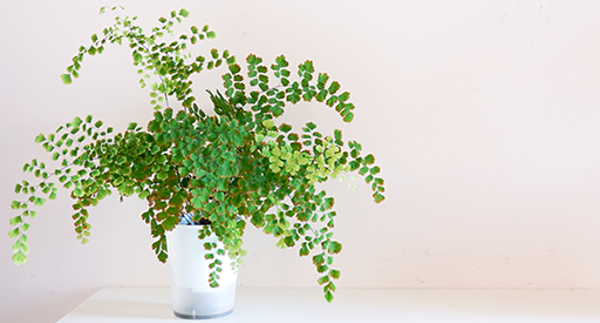
5 Steps to Growing Maidenhair Ferns
- Select a suitable sized pot with good drainage
- Add a layer of indoor plant mix to plant into
- Choose a shady spot with partial sunlight
- Water thoroughly and ensure the soil is kept moist
- Apply a general purpose fertiliser once a month during the growing season
Follow our full guide and plant care tips to growing Maidenhair ferns below.
Ferns are another great indoor addition to dress up your indoor space and the Maidenhair fern is a classic indoor plant. It is a versatile foliage plant and is available in a variety of textures and sizes to suit the style of your room and add interest. Maidenhair ferns are lovely fillers for pot plants. They like a brightly lit position indoors and plenty of water.
PREPARE
The better the soil, the better your indoor plants will grow. Healthy soil is especially important when growing in a limited area. Choose a potting mix that is free draining like Tui Indoor Plant Mix, specially formulated with the right blend of nutrients to give your indoor plants in pots and containers the best start.
Select a container that is a suitable size for your plants. Ensure the container has enough capacity to house the roots of the plants you want to grow. Drainage is also essential, so keep this in mind when choosing your perfect pot. The bigger the pot the bigger your plant will grow. Maindenhair ferns like to be root bound, to keep the pot on the smaller side.
PLANT
Check plant labels for individual planting instructions.
- Water plants thoroughly before potting and allow to drain.
- Partly fill your container with Tui Indoor Plant Mix.
- Gently take the plant from the current container (be careful when handling the roots of this plant as).
- Position the plant in the centre of the new container and fill with Tui Indoor Plant Mix up to 3cm from the top.
- Gently firm the mix around the plant. The mix should be at the same level on the plant as it was in the previous container.
Light
The right plant in the right place is the secret to healthy indoor plants. In their natural forest environment, maidenhair ferns are primarily covered by a canopy of trees, receiving a bit of shade and a bit of partial sunlight. To successfully grow the fern indoors, it's best to try and mimic these conditions by finding a spot in your home that receives indirect sunlight only.
NOURISH
Watering
Your best bet when it comes to ensuring your maidenhair fern thrives is to focus on multiple water sources for this thirsty species. Consistently moist soil is a great place to start—from there, be sure to water your fern consistently, either daily or every other day, never allowing the soil to dry out. This fern requires very warm, humid air. To mimic its ideal conditions, mist the plant with warm water a couple of times a day in order to maintain the proper moisture levels on its delicate leaves.
Feeding
Tui Indoor Plant Mix contains a starter fertiliser to provide instant nutrients and prevent transplant shock, along with a controlled release fertiliser for sustained feeding for up to six months, however continuing to replenish nutrients will ensure your plants remain healthy. Apply a general purpose fertiliser like Tui Enrich Pour & Feed Indoor Plant Liquid Fertiliser once a month during spring and summer, or for a sustained feed for up to 6 months use Tui Enrich Pots & Containers.
Common problems
Inconsistent watering is the main problem with maidenhair ferns. Keeping the soil moist but not wet is the key to making maidenhair fern happy. Watering too often causes the lacy fronds to yellow and wilt. Wet soil will eventually lead to root rot or other fungal diseases. Not watering often enough also causes the leaves to wilt.
Well nourished and cared for plants will be more resilient to common problems including temperature fluctuations, pests and diseases.
Pet friendly
This plant is considered non-toxic to cats and dogs.